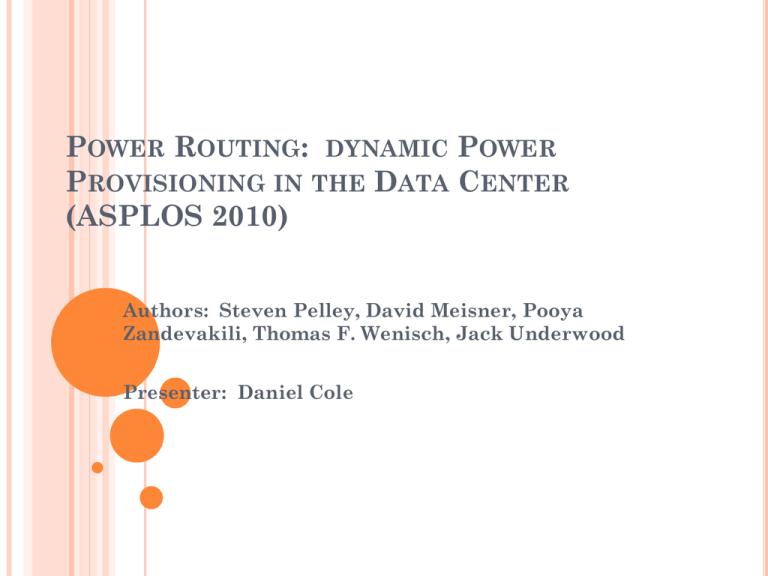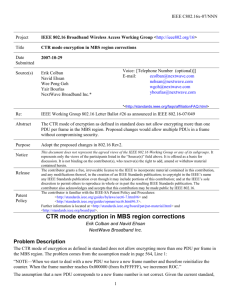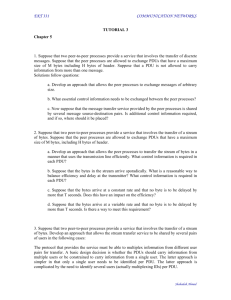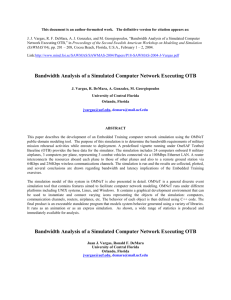Slides
advertisement

POWER ROUTING: DYNAMIC POWER
PROVISIONING IN THE DATA CENTER
(ASPLOS 2010)
Authors: Steven Pelley, David Meisner, Pooya
Zandevakili, Thomas F. Wenisch, Jack Underwood
Presenter: Daniel Cole
CONCEPT
Instead of “routing” power by dynamically
changing the requested power of components
(speed scaling, job distribution) this paper seeks
to actually dynamically change all components’
sources of power.
The goal is to reduce capital costs by allowing
each power distribution unit (PDU) to run with
less capacity thereby reducing the number and/or
size of the required PDU’s
Recall that “The cost of building datacenter
facilities capable of delivering a given power
capacity to such a computer can rival the
recurring energy consumption costs themselves.”
– Fan, et al.
HIGH-TIER DATA CENTER (WRAPPED
TOPOLOGY)
In the event of PDU failure, half of its load fails
over to its neighboring PDUs
EXAMPLE
Worst case
means we can
handle this if
B,C,D, & E
are all “full”
Fail
WHAT IF WE DISTRIBUTE A,B,C, & D AMONG
ALL PDUS? (SHUFFLED TOPOLOGIES)
We still have
the same
base load but
our needed
reserve is
smaller.
Fail
TOPOLOGIES
DYNAMIC POWER ROUTING
Each server is assigned to get power from its
primary or secondary power feed as well as a
power budget
When the server hits its power cap, it can request
more power
If the feed that the server is getting power from
can spare more power the server’s budget is
increased
If not, then the scheduler creates a new
assignment of power feeds and budgets to servers
in an attempt to prevent performance throttling
Scheduler ensures that any single PDU failure
can be handled
WHY NOT JUST USE SHUFFLED
TOPOLOGIES?
Individual PDUs are unlikely to reach peak load
simultaneously. (Need heterogeneity in global
workload.)
If all PDUs are either under or over provisioned,
power routing doesn’t help.
If one or more PDUs are over provisioned,
normally, we would just have to throttle the
servers on the over provisioned PDU
WHEN AGGREGATE POWER
INFRASTRUCTURE MEETS DEMAND
If we fix our PDU
capacity we can compare
performance vertically.
If we fix our
performance we
find the required
PDU capacity at
the leftmost
intersection
point.
NEW ASSIGNMENT SCHEDULING
Input: Set of servers and PDUs, each server is
connected to 2 PDUs, and has a desired power,
each PDU has a power capacity
Output: Each server assigned to one of its PDUs,
any single PDU failure can be handled by failover
Not formally defined in the paper.
REDUCTION (WITHOUT
REDUNDANCY)
NP-hard:
Reduction from PARTITION:
But with redundancy enforced, this reduction doesn’t
work, as the Power Routing instance has no solution
PARTITION instance: set of positive integers, want a partition
of the set such that they have equal value
Power Routing Instance: 2 PDUs, each with capacity equal to
half the value of the set, set of integers is the set of server
power requests
For any two PDU instance, we always need two PDUs both
with capacity equal to the total aggregate demand to allow
single PDU failure
They say “power feed assignment...even without
redundancy, is an NP-complete problem.”
But redundancy seems to make the problem easier for at
least certain cases (any case with 2 PDUs).
SOLUTION: LP WITH FRACTIONAL POWER
Input:
Power(i,j) is total requested power by any server connected to
PDU i and j
Capacity(i) is capacity of PDU I
Variables:
For all possible PDU pairs: Feed(i,j)-i and Feed(i,j)-j, i.e., the
power to each feed for servers that are connected to i and j
Slack: minimum slack between any feed and its capacity
Objective: Maximize Slack
Constraints (For all i,j):
Feed(i,j)-i + Feed(i,j)-j = Power(i,j) [feed’s must supply needed
power]
Sum_k Feed(i,k)-i + Sum_{l in j’s PDU} Feed(i,l)-l + Slack <=
Capacity(i) [All power a feed handles plus what fails over to it
if j’s PDU fails]
PDUs actually have multiple feeds which all need to be within
a certain factor of each other (omitted)
WHEN FRACTIONAL SOLUTIONS DON’T
DIVIDE
Sort power requests for Power(i,j) and give the largest
to the feed with the largest amount of its Feed(i,j)-i
remaining, repeat until all servers assigned
At worst 1 is not assigned:
Will be assigned to the feed with the largest remaining
capacity once all servers have been assigned
If capacity constraints have been violated by nonfractional assignment they formulate a new LP that
selects power caps by maximizing the sum of the
server budgets while ensure PDUs maintain capacity
requirements
This LP is only described in a few sentences and is
probably not used all in their experiments because they are
looking for minimum capacity to avoid capping, thus they
would never use this.
EVALUATION
Traces of server utilization (once per minute):
A small cluster of departmental web servers
1.5 MW facility for clinical operations
4MW facility for high performance computing
Hypothetical Facility:
400 medical center servers
300 high performance nodes
300-node web search cluster
Utilization converted to power using SPECPower
benchmarks
Primary evaluation benchmark is minimum total
power capacity required to assure zero
performance throttling
IMPACT OF SHUFFLED TOPOLOGIES
Result of
imbalances
across PDUs.
If server power
draw could be
fractionally and
dynamically split.
CLOSING THE GAP
32% savings
compared to
Wrapped without
power routing.
NUMBER OF PDUS
“For a fixed total power
demand, as the number of
PDUs increases, each
individual PDU powers
fewer servers…With fewer
servers, the variance in
power demands seen by
each PDU grows and it
becomes more likely an
individual PDU will
overload.”
HOMOGENEOUS WORKLOADS
ENERGY PROPORTIONAL SERVERS
Power draw varies linearly with utilization, static
power is 10% of peak
Rerun the Power Routing experiment
Trace Comparisons:
Time-Avg
Maximum
σ
Original
180.5 kW
208.7 kW
9 kW
Erg. Prop.
99.8 kW
153.9 kW
18.9 kW
ENERGY PROPORTIONAL SEVERS
SUMMARY
Shuffled Topologies: Allow reserve capacity to be
spread among more than 1 PDU so that in the
even of a fault more PDUs handle the failed
PDU’s load, but each receives a smaller amount
Power Routing: Even in an under provisioned
data center a single PDU may experience a spike
requiring power capping. However other PDUs
probably aren’t experiencing a spike. We would
like to route this spare power to the servers on
the spiking PDU.











